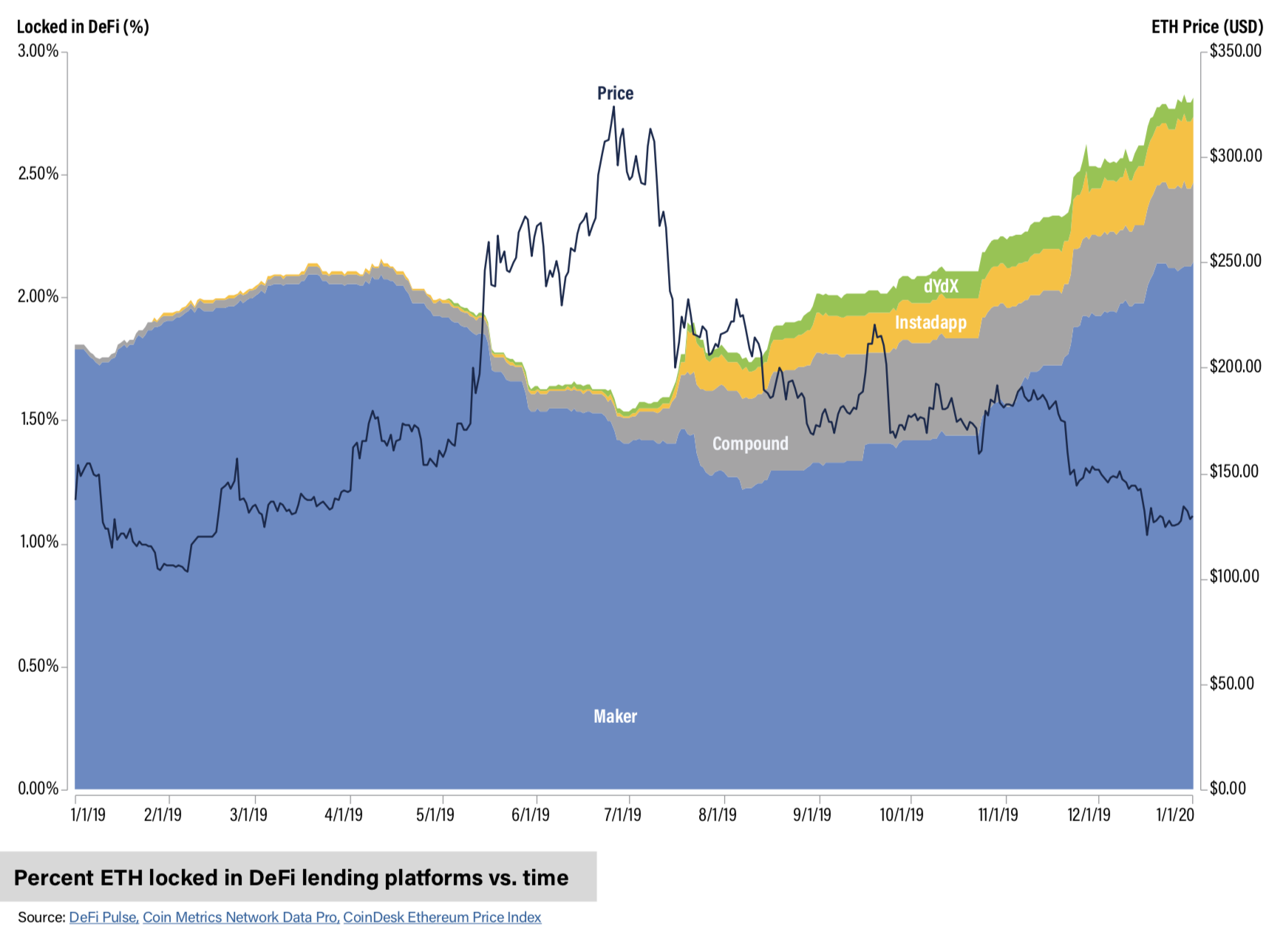Blockchain Bites: XRP’s Rally, Chainalysis’ $1B Valuation, Bitcoin’s Volatility in Perspective
Blockchain Bites: XRP’s Rally, Chainalysis’ $1B Valuation, Bitcoin’s Volatility in Perspective
The U.S. government is using Circle’s USDC to bypass Venezuelan blockades. Chainalaysis is looking to raise $100 million in fresh capital at a $1 billion valuation. Billions of dollars from institutional players are flowing into Coinbase. And VanEck found that bitcoin is less volatile than a quarter of S&P500 stocks, reigniting the case for a bitcoin ETF.
Top shelf
Injecting “stability”
An unnamed U.S. government agency has enlisted dollar-backed stablecoin provider Circle and P2P payments startup Airtm to support Venezuelan politician Juan Guaidó’s bid for office. The plan is to distribute relief funds to medical workers and other Venezuelan locals, bypassing restrictions set up by Venezuelan President Nicolás Maduro, who was re-elected in a 2018 election, by converting U.S. seized funds into Circle’s USDC product and dispersed via Airtm’s mobile phone network. “This is, in a sense, a way to bypass the state-controlled banking system and just directly distribute to people,” Circle’s Jeremy Allaire said, adding this is likely the first U.S. foreign policy objective utilizing a cryptographic stablecoin.
Private eyes
Chainalysis expects to raise $100 million venture capital at a $1 billion valuation in a fast-approaching Series C. Led by VC newcomer Addition with participation expected from Accel, Benchmark and Ribbit, the round could propel the blockchain analysis startup to unicorn status (a rarity for crypto). Several governments, banks, regulators and crypto firms rely on Chainalysis technology, seen in the company’s financial status: The firm increased its customer base 65% from Q3 2019 to Q3 2020. In other blockchain sleuthing news, analytics firm Coinfirm found government agents frequently leave behind “substantial” amounts of forked cryptos in seized wallets. Finally, CipherTrace has filed for two patents related to sniffing out privacy-preserving monero (XMR) transactions.
Open banking
The U.S. Office of the Comptroller of the Currency, a national bank regulator led by former Coinbase counsel Brian Books, has proposed a rule that would forbid banks to blacklist legal, but unsavory businesses – potentially including crypto firms. Under the proposed rule, banks could deny financial services to customers only on the basis of “quantitative, risk-based standards established in advance,” not in response to political pressures. Crypto firms have long struggled to obtain or keep bank accounts in the U.S., with only a handful of friendly providers – namely, Silvergate Bank, Signature Bank, and Metropolitan Commercial Bank. The proposal is open for public comment through Jan. 4.
$20B BTC
Coinbase now custodies $20 billion in institutional assets, an exchange executive claims. Brett Tejpaul said the institutional assets business was under $6 billion when he joined the firm in April and has grown by $14 billion under his watch. Notably, Tejpaul pointed to Coinbase’s Tagomi acquisition in May as a boost. “It radically transformed our ability to cater to institutional clients that want to use smart order routing and algorithmic execution,” he said. The veteran banker also said that adding JPMorgan Chase as its banking partner and Deloitte as its auditor has given Coinbase more compliance credibility. The firm is now measuring new capital coming in for bitcoin in the billions, Tejpaul said.
CBDCs not crypto?
China Construction Bank (CCB), the world’s second-largest bank, has suspended the upcoming listing of a $3 billion bond issuance that was intended to be tradable for bitcoin and U.S. dollars. The bank was sponsoring the issuance of the Longbond debt securities, set to be traded via the Fusang digital asset exchange. Now the program is being re-evaluated. In other news out of China, the city of Suzhou will hold the second lottery of the country’s central bank digital currency (CBDC) next month (this time with additional features like smart touch payments.) This follows on China’s President Xi Jinping comments at the G20 that CBDCs are to be embraced by developed nations.
Quick bites
- YER ORANGES: Sean Ono Lennon, musician and younger son of Beatles legend John Lennon, appeared on the Orange Pill Podcast on Sunday to say bitcoin is a tool for empowerment and among a few optimistic developments for “the future and humanity in general.”
- UP & RUNNING: KuCoin, the Singapore-headquartered digital asset exchange that was hacked to the tune of $281 million in September, said it has restored the deposit and withdrawal services of all tokens as of Sunday.
- DOMAIN BREACH: Cryptocurrency trading platform liquid.com and crypto mining firm NiceHash were two of at least six firms that had control of their domains briefly transferred to malicious actors last week after employees at GoDaddy, the world’s largest domain registrar, were tricked by fraudsters.
- YOU GOTTA BE GERKIN ME?! Popular decentralized finance protocol Pickle Finance was hacked on Saturday, draining $19.7 million in DAI, a decentralized stablecoin pegged to the U.S. dollar, from Pickle’s latest arbitraging smart contract.
- MOVING IMAGE: A programmable painting of Ethereum co-creator Vitalik Buterin set records this weekend when “EthBoy” sold for 260 ETH (ETH, +12.69%). The painting utilizes new cryptographic tooling to refashion itself everyday based on a bevy of market and community data.
Market intel
Leveraged buyers
Some BTC traders may have become overleveraged during the recent rally above $18,000, according to one key metric. The average level of the “funding rate” across major exchanges has risen sharply from 0.023% to a five-month high of 0.087% in the past 48 hours, according to data source Glassnode. The funding rate reflects the cost of holding long positions – measured by the premium derivative plays pay over spot prices. A higher number indicates excessively bullish, and therefore overbought, conditions. In such situations, a pullback or consolidation can trigger an unwinding of longs, leading to a deeper drop and a pick up in price volatility.
XRP pumps
XRP, the native asset of the XRP ledger, is riding 16-month highs. On Saturday the third-largest crypto by market cap climbed to $0.437564, the highest price since July 2019, according to the CoinDesk 20. It has continued to rise, with minor contractions, since. Now above the $0.50 level, XRP has appreciated over 120% since the start of the year.
At stake
Volatility, market data and ETFs
A new analysis from VanEck, a major investment management firm, found that bitcoin is less volatile than the S&P’s benchmark stock index.
The report, published Nov. 20, compared BTC to the companies listed on the S&P 500, finding the cryptocurrency was less volatile than 22% of these stocks over the past three months.
“Historically, bitcoin has been discussed in the news and among investors as a nascent and volatile asset outside of the traditional stock and capital markets,” the report reads. VanEck attributed this volatility to bitcoin’s relatively small total market size, regulatory blockers and limited participation from traditional asset managers.
But bitcoin’s volatility is not an aberration, as over the 90-day period measured ending Nov. 13 some 112 stocks experienced as much or more price volatility. Further, over the past year, 29% of S&P stocks were more volatile than bitcoin.
As CoinDesk Director of Research Noelle Acheson noted in a September newsletter, volatility is frequently and erroneously conflated with risk.
“Volatility is a metric, a number, a measurement. Risk is an ambiguous concept,” she writes, adding that volatility can be an attractive attribute for a well-weighted portfolio.
In Acheson’s analysis, she found bitcoin volatility is often correlated with the asset’s price direction: That is, when the price comes down, so usually does the volatility.
In comparison, the CBOE Volatility Index (VIX), which measures the S&P 500 implied volatility, tends to move inversely to the S&P 500. “The average 60-day correlation between the two for the month of August was -0.84, an almost perfect negative association. Using bitcoin’s 30-day realized volatility as a proxy for a bitcoin VIX, we get an average 60-day correlation for August of 0.45. A very different scenario,” she found.
What’s more, bitcoin’s volatility is more measurable than traditional markets, as the crypto trades 24/7 freely across the world. More data points means more data to analyze.
It’s for these reasons, bitcoin’s similar volatility and market information, that many feel comfortable for agitating for a BTC exchange-traded fund. As reported, U.S. regulators have been hesitant to accept crypto ETF products, often citing a lack of cohesive market data.
But a sober look at the real market conditions may point the other way.
VanEck ends its report saying: “While there are no U.S. bitcoin exchange-traded funds (ETFs) available today, we believe such products may show similar volatility characteristics – based on the comparison above – as many stocks in well-known indices and ETFs, such as the S&P 500 and related products.”
Food for thought











